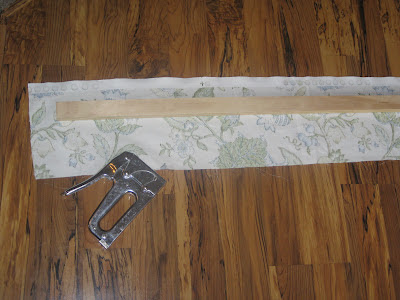I found a website Terrell Designs, who is a roman shade pro. I watched her tutorial on "how to make a roman shade", and combined quite a few of the steps she suggested, along with some of the ideas I got from the custom roman's we had made for my client. One of my favorite things about Terrell's website, is her roman shade hardware calculator (you can find the link for it on the right side of her homepage). It conveniently instructs you on fabric measurements, how many battens and lift lines you need and where to put them, and stackage information...all based on the measurements of your window.
Here are some of the roman shades I have made over the years with the tutorial you will see below...
And most recently, the one I did this week for my loft makeover:
Here is my tutorial on making a roman shade! -
Start by measuring your window, the window I did above is 46.5 inches wide by 46.5 inches long. I started by cutting my fabric 47 inches wide by 61 inches long. I always add 1/2 inch to the width for my final measurements (I do 1/4 inch seams), and about 5-8 inches more in length than the hardware calculator states due to the difference in my construction of the shade.
When filling out the hardware calculator for your shade, you will need to enter three numbers...your window width, window length, and ideal stackage. Stackage is the the length of your shade once it is drawn all the way up. The general rule for ideal stackage is 15-20% of your window length. Since my window is 46.5 inches long, 20% is just under 10 inches. It is a personal preference how long you want your shade length to rest when drawn. I prefer mine longer so you can see more of the fabric, which is why I chose 10" inches for my stackage.
After I cut my fabric out to the specifications I needed, I cut out the drapery liner as well. I used to use muslin to back my fabrics; however, I now use Roc-lon drapery fabric instead. It helps protect your fabric from UV rays and is very easy to work with. You can find it at most fabric stores.
Place your fabric and liner fronts together. Sew the sides and one end of the combined pieces (that end you sew will be the bottom of your shade). -
Now you have to create your batten/wood dowel pockets.
For my particular window, the hardware calculator stated the following:
"Place first (lowest) batten 6.75 inches up from the bottom of the shade. This is the Lower Drop."
Remember, the bottom of your shade is the part of your shade that is sewn. Start from the bottom and measure for the lowest batten/dowel. You will be creating a pocket in the back of your shade for a 3/16 of an inch batten/wooden dowel (I purchase mine at Lowes or Home Depot).
The website indicated to have my first batten/dowel 6.75" from the bottom of my drape. To do this, I measured and pinned 6.75 inches up from the bottom edge -
Once you have pinned where your first batten/dowel is supposed to go, fold the fabric over exactly 1/2" inch above this pinned line -
Sew along this folded line 3/8" of an inch in from the folded edge. This will create the pocket for your batten/wood dowel -
The hardware calculator then indicates for me to space the remaining 5 batten/dowel pockets 6 inches apart. So, I continue the step above; however, this time I measure from the seam I just completed on the first batten/dowel pocket and pin 6 inches up.
After sewing all the batten/dowel pockets, I end up with this -
back:
front:
Cut your batten/wood dowels to fit your window treatment width, and slide into the pockets (make sure to put these dowels in BEFORE you you follow the next step, sewing on the lift rings). -
Next I needed to install my lift lines. Lift lines are the rows of cording that lift your drape up. Once again, the hardware calculator indicated for my project that I would need to do 4 lift lines.
I like to put the first two of my lift lines on the ends of my drape (attaching the plastic lift rings 1" inch from the edge of the drape), and centering out the remaining ones -
Always sew your lift rings on every other batten/dowel pocket, starting with the lowest pocket -
Next, cut a 1x2 inch board the width of your window (my case 46.5"inches) and wrap it a piece of left over fabric -
Measure out and screw in "eye screws" onto this fabric covered board so that they line up perfectly with your lift lines -
Attach your drapery cording to your bottom lift rings and thread through all the lift rings and eye screws on the top board. I always have my pull cord hang on the right of my drape, so my far left cord needs to be my longest, getting shorter and shorter, with the shortest being on the side gathering to form the cord pull. -
You will have extra fabric on the top of your drape that you will need cut off once you attach your fabric covered 1x2 inch board to the top of your drape. A few times I didn't make mine long enough for my window which is the reason for adding the extra fabric to the length at the beginning of this project.
Simply staple the top of your drape to your 1x2 inch board where the bottom of your drape hits the window sill perfectly, and cut off excess fabric -
To mount the drape, screw the 1x2 inch board into the inside of your window frame -
Use a "cord cleat" to wind your cord pull up when the drape is drawn-
And there you have it! I hope this tutorial makes sense and is helpful, and saves you a bundle of money by creating your own beautiful window coverings!!






















11 comments:
With that easy-to-understand tutorial, I'm sure lots of people will be engaged to make one of those in any kind of fabric, whether new or recycled. Besides, Roman shades do not only look neat and orderly just like any blinds or curtains. This type also blocks light from outside when needed, and makes a good insulator for cooler summer days.
is there a trick to keeping the fold/sew line for the dowels nice and straight? Do you pin every few inches and iron it before sewing it?
I mark with tape on my sewing machine where I need to follow to keep the correct width. After pinning the fold, I just run it along the tape, carefully keeping an eye on it. Hope that made sense! :)
The link to the calculator on Terrell Designs web site is not working and Terrell's web site is under construction. Do you have any other way to get to the calculator?
Yes, I have used terrell's calculator in the past, but am unable to open her website, does anyone have a hardware calculator similar to this one??
JML
What type of lift cord do you use and where do you purchase it?
I found a similar calculator on sailrite.com. The calculator link is towards the bottom of the home page and is called a fabric calculator.
JML, what's your email address? I"ll email you what I have.
do you use a weighted rod at the bottom? how do you secure this?
No, I did not use any rod or weights in the bottom of my shade.
I was a big fan of Terrell Designs. Her website was EXCELLENT. WHEN SHE WAS GOING OUT OF BUSINESS, I PURCHASED HER HARDWARE CALCULATOR FOR ROMAN SHADES BUT I AM UNABLE TO DOWNLOAD IT. DOES ANYONE HAVE ONE THEY WILL SHARE WITH ME. I HAVE NOT BEEN ABLE TO FIND ONE AS GOOD AS HERS. Thank-you
kakie.duren@gmail.com
Post a Comment